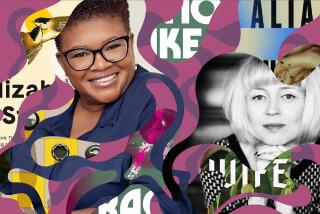‘White’ into ‘Black’
- Share via
WHILE Janet Fitch worked on the follow-up to her multimillion-selling debut novel and Oprah’s Book Club pick “White Oleander,” she listened to a particular cassette over and over again. It was a mix tape of what she called “the saddest songs in the world,” full of morose folk musings by Leonard Cohen and Joni Mitchell. But the saddest song of them all, she said, was Janis Joplin’s take on Gershwin’s “Summertime.”
“She wants to believe in what she’s singing so badly,” said Fitch, sitting in the living room of her tastefully cluttered home in the Silver Lake hills. “But you can hear that she’s about to go under.”
“Paint It Black,” which hits bookstores this week, follows two similarly unraveling characters haunted by memories of a loved one who went under in grisly, violent fashion. It would seem a natural second novel for the third-generation L.A. author, whose living room is lined with vintage records by Roxy Music and David Bowie and pencil sketches by her 16-year-old daughter, Allison.
But Fitch didn’t plan it that way. Somewhere in her house is a box filled with hundreds of pages of a weighty historical novel that, in a fit of decisiveness following months of dread, she decided to abandon in the middle of a photo shoot for that book’s jacket cover.
“When you have success, people think you know what you’re doing, and you start to agree with them, you think you can conquer the world,” she said. “But you go from grandiosity to panic. My editor would call and I’d say ‘It’s fine, going great,’ and I couldn’t bring myself to admit it wasn’t happening. It was an abortion.”
Fitch was then forced to tearfully admit to her editors that, after having twice written the 300-page book using two different narrators, she still didn’t have anything that she was proud of. For a mid-list author with few expectations for big sales figures, that might not have mattered. But “White Oleander” was a blockbuster, one of the bestselling new works of literary fiction that year. It had been adapted as a movie starring Renee Zellweger and Michelle Pfeiffer. Janet Fitch was a bankable name. Michael Pietsch, who edited “White Oleander” for Little, Brown, had to adjust his time frame once again. “She sent the manuscript to us, and I think she arrived at the right decision,” he said. “I was sad for Janet because all that time and work must have been a great loss. But I was very grateful that she had the maturity and self-assessment to put that aside. It’s the process that brought us ‘Paint It Black,’ and I’m glad it happened so that we have this book.”
While Fitch may have felt liberated by bailing on the project, it still left her with the task of writing an entirely new novel. She revisited a story-length sketch of two resilient women desperately searching for family -- a return to the emotional core of “White Oleander.” This time, though, the setting was Echo Park during the ramshackle punk culture of the ‘80s, when teenage vagabond Josie Tyrell learns that her boyfriend, Michael, a Harvard dropout and aspiring painter, has fatally shot himself in a desert motel. As Josie mourns his suicide, she becomes entangled with his mother, Meredith, a wealthy classical pianist who blames her for Michael’s depression.
With its backdrop of crumbling Hollywood flophouses, Darby Crash’s nihilistic sneering and the social specter of Reaganomics, “Paint It Black” became a historical novel of sorts, but a far more personal one for Fitch.
“I was a bit older than those kids, but I can remember the defiance, of not needing permission to breathe, that you don’t need a credit card to have a right to be here,” she said.
As Josie drives past the rotting bohemian bungalows of Echo Park and Didion-esque stretches of forgotten desert highway, Fitch uses the city’s structures as characters themselves. Josie and Michael’s tiny, mural-painted home becomes for Meredith tangible proof that her child could love another woman, and Josie spends much of the book hovering around Meredith’s Los Feliz palace in literal and metaphorical intoxication.
“L.A. is such a real, active place,” Fitch said. “My mother was very into the core of the city. She worked in politics, and you have to know your territory. It’s an active matrix, we’re all parts of it, but people don’t often stop to wonder what’s going on.”
Fitch is the rare local writer who has achieved Hollywood-level popular success writing fiction about Los Angeles life. With “White Oleander,” she found a kind of literary sweet spot: serious fiction that’s not so challenging or unsettling that it can’t spend multiple weeks on bestseller lists -- or nab a lucrative spot in Oprah’s Book Club -- and “Paint It Black” looks to be working that same terrain. Early reviews have been strong. But Fitch said she “never expected my writing to support me,” and neither her creative process nor her social sphere has really changed from those early years when she spent her nights in Kate Braverman’s living room workshops, hashing out short stories with other struggling local writers and fleshing out the first scenes of new stories.
“You know how some people in writing workshops are stars of the group? Janet was not the star,” said Samantha Dunn, co-editor of the anthology “Women on the Edge: Writing From Los Angeles,” for which Fitch wrote the introduction. “But she kept at it. She’s done an amazing job of keeping a level head, and she’s gone out of her way to bring everybody along with her. She’s a 3 a.m. kind of friend.”
After the lonely failure of her abandoned novel, Fitch decided that she couldn’t write “Paint It Black” alone. She began hosting a regular workshop in her home, with writers David Francis, Julianne Ortale and Rita Williams, all editing each other’s projects.
“When working on your own, you can make a choice and find out six months later that you made a bad choice,” Fitch said. “But when you work with people you trust, who understand your obsessions, you can take risks.”
Considering the wealth of images and emotional highs and lows that now seem like Fitch’s calling card, “Paint It Black” feels tight and confident. In Fitch’s brisk sentences Josie’s grief unspools at a relentless, sometimes exhausting pace. (When Josie visits the motel room where Michael shot himself, she “sat in the bed, arranged the pillows behind her. He’d poured himself a last shot of mescal. I’m sorry. I just want it to stop now. And put the gun in his mouth, sour, cold, smoky. She put her own two fingers in her mouth. I’m so sorry. And pulled the trigger.”)
Josie is, somewhat annoyingly, given to drinking “voddy” and smoking “ciggies,” and Fitch has a habit of closing chapters with baroque dream sequences. But even these tics feel true to the way 19-year-olds process both boredom and blinding emotion.
“Nineteen is as alive as 40-plus. I can vividly remember 19 and how I saw the world,” Fitch said.
Pointing out her daughter’s art projects around the room, including a plaster chair sculpture embedded with beer-bottle tops, Fitch seemed confident that she’ll always remember being young. “The difference between writers and others is that we have memories like elephants when it comes to states of mind.”
In 2003, as she started over with “Paint It Black,” Fitch was ending her 17-year marriage to Steve Strauss. The divorce was “long and complicated,” she said, and politely declined to say more. Her new novel is an exploration of grief, but Fitch seems ready to look forward in her own life.
“Josie’s self-hatred is part of the young-adult world,” Fitch said. “My own psychology has settled down. Life in general is pretty good. But it’s not always ‘There, there.’ That comes after a lot of therapy.”
More to Read
Sign up for our Book Club newsletter
Get the latest news, events and more from the Los Angeles Times Book Club, and help us get L.A. reading and talking.
You may occasionally receive promotional content from the Los Angeles Times.








